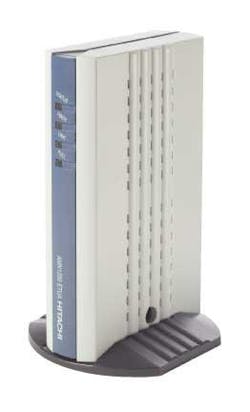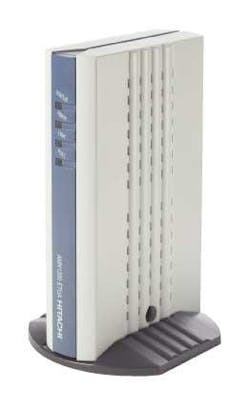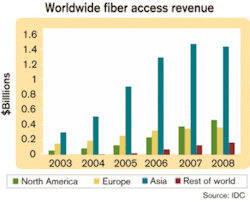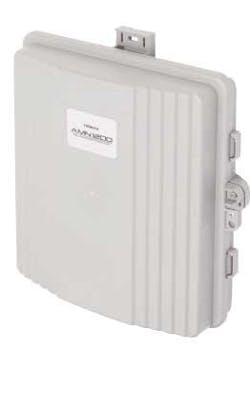Japanese fiber to premises deployments worth watching
Japan represents the largest-and to date most successful-wide-scale fiber to the home (FTTH) deployment in the world. According to Hiroshi Ishikawa, president and CEO of NTT Advanced Technology, the R&D arm of NTT East and West, 50% of Japanese households have fiber service directly to the home. Thanks to a competitive marketplace and supportive government policies, broadband service in Japan is the cheapest in the world, at 18¢ per 100 kbits/sec (compared to $2.86 in the United States and $7.18 in the United Kingdom). Japanese subscribers are adopting FTTH at a rate of 80,000-90,000 subscribers per month. So what’s next for Japan? And what can U.S. providers learn from Japan’s aggressive FTTH deployment plans?
“Historically, the Japanese market has been way ahead of everybody else in terms of FTTP,” contends Emmanuel Vella, chief marketing officer at Wave7 Optics (Alpharetta, GA), which just landed an FTTP contract with Japanese cable operator Izumo Cablevision. “The evolving market trends there are interesting to watch because they could really affect or at least mirror some of the things that may happen here in the next 12-18 months.”In the U.S., carriers, especially RBOCs, are driving FTTP deployments in an attempt to compete with the cable multiple-system operators (MSOs). Municipalities and utility companies are also embracing the technology to stimulate the local economy and boost the attractiveness of their communities. But in Japan, the consumers themselves are leading the charge; high-speed broadband is viewed as a status symbol. “No consumer would accept the 1.5-Mbit/sec to 3-Mbit/sec limitation currently in place in the U.S.,” reports Scott Wilkinson, assistant vice president, product management, at Hitachi Telecom (USA) (Norcross, GA). To date, Hitachi has been the primary supplier of FTTH equipment to NTT East and West, the incumbent carriers in Japan.
The business model in Japan is predicated on simply providing high-speed access. “You provide enough bandwidth,” says Wilkinson, “and you’ll make money.” The services will follow where the bandwidth leads. Unlike the U.S. carriers, the Japanese incumbents provide bandwidth only; ISPs provide the services, and content providers provide the content. Select services are sometimes offered as an incentive to sign up for FTTH; NTT East, for example, provides free video on demand (VoD) channels in certain areas of Tokyo. But these services are strictly used to entice new subscribers and are not regarded as an independent revenue source.
FTTH is regarded as a means to leapfrog over the competition, which in Japan means DSL. According to the Japanese Ministry of Public Management, Home Affairs, Posts, and Telecommunications, there were 12.7 million ADSL users in Japan at the end of June. (By contrast, cable-modem users topped 2.7 million, and FTTH subscribers numbered 1.4 million.) DSL modems are handed out for free in the subways and train stations in Japan, and DSL download rates of 40 Mbits/sec are common.
That said, bandwidth-hungry subscribers in Japan also regard DSL as unfair. The further subscribers are from the central office (CO), the less bandwidth they receive; only those closest to the CO achieve the full 40-Mbit/sec speeds. FTTH, on the other hand, offers the full 50 Mbits/sec to all subscribers, regardless of their distance from the CO.
In addition to the steep competition from DSL, a strong government policy on broadband is also driving deployments in Japan. “In many Asian countries, the regulatory environment is built around creating incentives to invest in fiber-it’s not as much of a free market approach, not as much ROI-driven [as in the U.S.],” notes Sterling Perrin, senior research analyst, optical networks, with IDC (Framingham, MA). “It’s a more proactive approach.” The e-Japan initiative, launched in 2001, aims to connect 30 million high-speed (30-Mbit/sec) subscribers and 10 million ultra-high-speed (100-Mbit/sec) subscribers via FTTP technology by 2006.
The distribution of population in Japan certainly favors an FTTH topology. “The service providers are justified in running fiber out to an apartment building and then distributing the capacity of that fiber to the many subscribers throughout the building,” says Perrin. “What they are able to do is share the cost of laying that fiber and of that capacity and certainly bring in revenue from multiple subscribers. This is much less common in the U.S., where the population is heavily dispersed.”NTT East and West originally deployed fiber access in a point-to-point configuration via media converter. In late 2002, NTT switched to a Full-Services Access Initiative (FSAN)-compliant broadband PON (BPON) architecture in an attempt to leverage its extensive ATM infrastructure. Deployments skyrocketed in July 2003, when NTT began to waive the $100-$125 installation fee. Roughly 80,000-90,000 new subscribers are connected every month, with a total of two million expected by the end of this year.
To boost performance even further, the Japanese government recently mandated a switch from BPON to Gigabit Ethernet PON (GE-PON) architecture, and all future deployments will be based on this technology, reports NTT’s Ishikawa. “GE-PON is more cost-effective and provides more bandwidth,” he explains. “Also, for performance, for video service in the future, GE-PON is recommended. For those who don’t need broadcast service, they can continue to use media converters.” At press time, NTT hoped to standardize on the GE-PON system this fall.
NTT’s initial adoption of ATM-friendly BPON, says Vella, is a strategy that many PTTs apply to their first rollouts of FTTP. “But at some point, you cap out capacity, and you start to look at what, in a greenfield application, you really want to deploy to support [new] services,” he notes. “IP Ethernet-based architectures are certainly very cost-effective versus the BPON approach. And Ethernet can support the quality of service mechanisms they need it to support now, whereas five or six years ago, it probably couldn’t. Ethernet is also well understood; there’s a standard evolving on the [IEEE] 802.3ah side, Ethernet in the First Mile.”
The Japanese incumbent carriers may be moving ahead with GE-PON, known in the U.S., as Ethernet PON (EPON), but it appears as though the U.S. carriers are leaning toward gigabit PON (GPON), an extension of BPON that is currently in development with the ITU. “In Asia, especially in places like China, the network is relatively new, and it is all IP-based,” reports Wilkinson. “In Asia, it’s all about getting the data out there, getting the high-speed bandwidth out and letting someone else put the service on top. GE-PON is fine for that, because all you are really providing is a lot of speed. Whereas in the U.S., people are trying to do ‘triple-play.’ They want to provide voice, they want to provide video, they want to provide all these other things, and the ITU version is better suited to that.”
Japanese carriers primarily provide data services, but to say that they are data-only is a bit of a misnomer. NTT is legally prohibited from providing broadcast video services, which is different from VoD. Broadcast video can provide an event in real time, like a live concert or a football game, whereas VoD provides strictly prerecorded content like movies. In Japan, households feature one screen for both computer and VoD applications; online instructions for installing high-speed data services into the home also include directions for setting up the home theater around the computer screen, says Wilkinson. That contrasts with the United States, where the home computer is used mostly for data services and is not placed in a prominent position.
Moreover, says Wilkinson, NTT will start offering a voice service on its PON system in select areas, primarily to compete against Yahoo! Broadband, which offers a service bundle of DSL and voice over IP.
Despite their dissimilar PON preferences, the Japanese and U.S. markets are actually very similar, surmises Wave7’s Vella. “You have your PTT, NTT, that is doing a lot of things. Then you have your cable MSO market, which really consists of three or four big guys like it does in the U.S. And then you have the municipalities and power-utility companies. They are all customers with an appetitive for fiber to the home.”
Wave7’s recent contract win with Izumo Cablevision is one example of the burgeoning alternative telecom market in Japan. The city of Taki-Cho, in the Shimane Prefecture, released an RFP detailing the amount of bandwidth it would need to support the services it wanted to offer, and the cable MSOs, including Izumo, responded. “The cable MSOs are not encumbered by the same regulations that affect the PTT,” explains Vella. “It’s very significant that they are migrating to an all-fiber technology to deliver triple-play services that compete directly with the PTT.”
The cable MSO industry in Japan “may be a foreshadowing of things to happen here in the U.S.,” he adds. “You have Verizon getting more and more aggressive with FTTP and deploying a conventional BPON topology. As they overbuild the cable companies, you may see the cable companies start to retaliate with some advanced architectures of their own.”
In a presentation delivered at the FTTH Conference in Orlando, FL, in September, Wilkinson detailed some of the lessons U.S. service providers might learn from the FTTP deployments in Japan. First and foremost, he says, the Japanese network is based on service requirements. Services are primarily IP-based; therefore, the PON interfaces and surrounding equipment are also IP-based. Cable TV is not very popular, so there is no need to provide RF video components. U.S. network providers should consider which services they hope to provide when designing their networks, he says.
The wholesale business model prevalent in Japan may also work for certain U.S. carriers. In Japan, the network provider wins business by providing the highest-speed network available to the customer. “They decided that if they just put a lot of bandwidth out there, they could sell services on top of it,” says Wilkinson. “If you look at something like UTOPIA [a consortium of 14 Utah cities building a fiber network to serve 140,000 homes and business], that is exactly what they are doing. They are providing a large-bandwidth network, and they are allowing other people to come in and sell services on top of it.”
Alternative carriers in the U.S. may also want to consider an Ethernet-only deployment as a way to provide high-speed data services to a community without having to compete directly with the cable MSO or the incumbent carriers. Moreover, U.S. carriers should consider deploying standardized equipment, asserts Wilkinson. Standards-based products benefit from economies of scale, allow multiple sources, and are interoperable. In Japan, “they decided on a PON system, and they decided on a standards-based system to try to keep costs down. All these things are good ideas that people in the U.S. ought to consider,” he says.
The United States is by no means the only country keeping its eye on the FTTP situation in Japan, however. “Japan, as a major market for fiber access, will have a tremendous impact on the worldwide fiber access market going forward,” reasons Perrin. “It’s likely that [NTT’s decision to adopt GE-PON] could resonate through different countries throughout Asia. Clearly, countries in Asia and even, it could be argued, around the world are looking at what is happening in Japan with fiber access and making their plans accordingly.”


